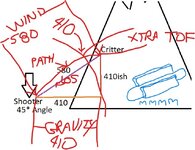wind gypsy
WKR
- Joined
- Dec 30, 2014
- Messages
- 8,384
A lot of this is hard to picture without the "sciency" framing, but it is correct.
But, we all know data is one thing, and shooting it is another. I invite everyone to try to shoot at a steep angle up or down a mountain. Almost guarantee that the dope will never match what you actually hit. Extreme angles introduce lots of influence from the change in position. The changes in centers of gravity significantly effect the recoil and influences on the rifle from the traditional flat shooting we do.
You mean to tell me that a guy with a Leupold CDS dial that is actually perfect for the atmospheric conditions and rifle/ammo on a scope that tracks correctly would still have a 0.4 mil (over 8") error on the OP scenario? gasp.


